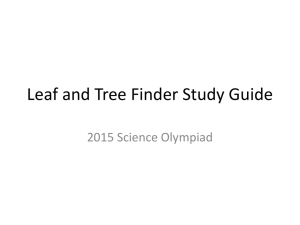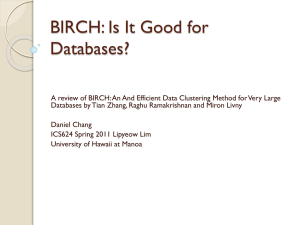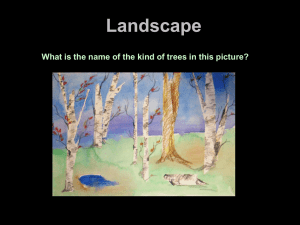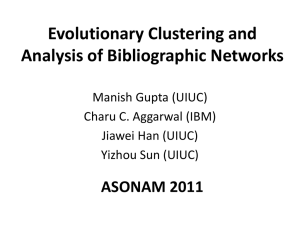The BIRCH Algorithm
advertisement
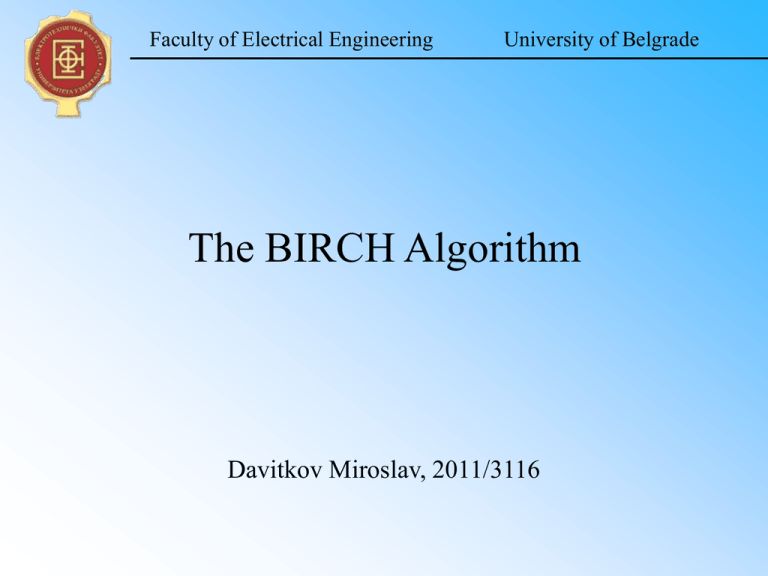
Faculty of Electrical Engineering University of Belgrade The BIRCH Algorithm Davitkov Miroslav, 2011/3116 1. BIRCH – the definition • Balanced • Iterative • Reducing and • Clustering using • Hierarchies 2 / 32 1. BIRCH – the definition • An unsupervised data mining algorithm used to perform hierarchical clustering over particularly large data-sets. 3 / 32 2. Data Clustering • Cluster - A closely-packed group. A collection of data objects that are similar to one another and treated collectively as a group. • Data Clustering - partitioning of a dataset into clusters. 4 / 32 2. Data Clustering – problems • Data-set too large to fit in main memory. • I/O operations cost the most (seek times on disk are orders of a magnitude higher than RAM access times). • BIRCH offers I/O cost linear in the size of the dataset. 5 / 32 2. Data Clustering – other solutions • Probability-based clustering algorithms (COBWEB and CLASSIT) • Distance-based clustering algorithms (KMEANS, KMEDOIDS and CLARANS) 6 / 32 3. BIRCH advantages • It is local in that each clustering decision is made without scanning all data points and currently existing clusters. • It exploits the observation that data space is not usually uniformly occupied and not every data point is equally important. • It makes full use of available memory to derive the finest possible sub-clusters while minimizing I/O costs. • It is also an incremental method that does not require the whole dataset in advance. 7 / 32 4. BIRCH concepts and terminology Hierarchical clustering 8 / 32 4. BIRCH concepts and terminology Hierarchical clustering • The algorithm starts with single point clusters (every point in a database is a cluster). • Then it groups the closest points into separate clusters, and continues, until only one cluster remains. • The computation of the clusters is done with a help of distance matrix (O(n2) large) and O(n2) time. 9 / 32 4. BIRCH concepts and terminology Clustering Feature • The BIRCH algorithm builds a clustering feature tree (CF tree) while scanning the data set. • Each entry in the CF tree represents a cluster of objects and is characterized by a triple (N, LS, SS). 10 / 32 4. BIRCH concepts and terminology Clustering Feature • Given N d-dimensional data points in a cluster, Xi (i = 1, 2, 3, … , N) CF vector of the cluster is defined as a triple CF = (N,LS,SS): - N - number of data points in the cluster - LS - linear sum of the N data points - SS - square sum of the N data points 11 / 32 4. BIRCH concepts and terminology CF Tree • a height balanced tree with two parameters: - branching factor B - threshold T • Each non-leaf node contains at most B entries of the form [CFi, childi], where childi is a pointer to its i-th child node and CFi is the CF of the subcluster represented by this child. • So, a non-leaf node represents a cluster made up of all the subclusters represented by its entries. 12 / 32 4. BIRCH concepts and terminology CF Tree • A leaf node contains at most L entries, each of them of the form [CFi], where i = 1, 2, …, L . • It also has two pointers, prev and next, which are used to chain all leaf nodes together for efficient scans. • A leaf node also represents a cluster made up of all the subclusters represented by its entries. • But all entries in a leaf node must satisfy a threshold requirement, with respect to a threshold value T: the diameter (or radius) has to be less than T. 13 / 32 4. BIRCH concepts and terminology CF Tree 14 / 32 4. BIRCH concepts and terminology CF Tree • The tree size is a function of T (the larger the T is, the smaller the tree is). • We require a node to fit in a page of size of P . • B and L are determined by P (P can be varied for performance tuning ). • Very compact representation of the dataset because each entry in a leaf node is not a single data point but a subcluster. 15 / 32 4. BIRCH concepts and terminology CF Tree • The leave contains actual clusters. • The size of any cluster in a leaf is not larger than T. 16 / 32 5. BIRCH algorithm • An example of the CF Тree root A Initially, the data points in one cluster. A 17 / 32 5. BIRCH algorithm • An example of the CF Тree root A The data arrives, and a check is made whether the size of the cluster does not exceed T. T A 18 / 32 5. BIRCH algorithm • An example of the CF Тree root If the cluster size grows too big, the cluster is split into two clusters, and the points are redistributed. A B B T A 19 / 32 5. BIRCH algorithm • An example of the CF Тree root At each node of the tree, the CF tree keeps information about the mean of the cluster, and the mean of the sum of squares to compute the size of the clusters efficiently. A A 20 / 32 B B 5. BIRCH algorithm • Another example of the CF Tree Insertion LN3 LN2 sc5 sc4 LN1 sc6 Root sc7 sc3 LN1 sc1 sc8 LN3 LN2 sc2 sc8 sc1 sc2 21 / 32 sc3 sc4 sc5 sc6 sc7 5. BIRCH algorithm • Another example of the CF Tree Insertion If the branching factor of a leaf node can not exceed 3, then LN1 is split. LN3 LN2 Root sc4 sc6 sc7 LN1’’ LN1’ sc1 sc8 sc5 sc3 LN1’ LN1’’ LN2 LN3 sc2 sc8 sc1 sc2 22 / 32 sc3 sc4 sc5 sc6 sc7 5. BIRCH algorithm Another example of the CF Tree Insertion • If the branching factor of a non-leaf node can not exceed 3, then the root is split and the height of the CF Tree increases by one. Root LN3 sc4 NLN2 NLN1 sc5 LN2 sc6 sc7 NLN2 LN1’ LN1’’ NLN1 sc1 sc8 LN1’ LN1’’ LN2 LN3 sc3 sc2 sc8 sc1 sc2 23 / 32 sc3 sc4 sc5 sc6 sc7 5. BIRCH algorithm • Phase 1: Scan all data and build an initial in-memory CF tree, using the given amount of memory and recycling space on disk. • Phase 2: Condense into desirable length by building a smaller CF tree. • Phase 3: Global clustering. • Phase 4: Cluster refining – this is optional, and requires more passes over the data to refine the results. 24 / 32 5. BIRCH algorithm 5.1. Phase 1 • Starts with initial threshold, scans the data and inserts points into the tree. • If it runs out of memory before it finishes scanning the data, it increases the threshold value and rebuilds a new, smaller CF tree, by re-inserting the leaf entries from the older tree and then resuming the scanning of the data from the point at which it was interrupted. • Good initial threshold is important but hard to figure out. • Outlier removal (when rebuilding tree). 25 / 32 5. BIRCH algorithm 5.1. Phase 2 (optional) • Preparation for Phase 3. • Potentially, there is a gap between the size of Phase 1 results and the input range of Phase 3. • It scans the leaf entries in the initial CF tree to rebuild a smaller CF tree, while removing more outliners and grouping crowded subclusters into larger ones. 26 / 32 5. BIRCH algorithm 5.1. Phase 3 • Problems after Phase 1: – Input order affects results. – Splitting triggered by node size. • Phase 3: – It uses a global or semi-global algorithm to cluster all leaf entries. – Adapted agglomerative hierarchical clustering algorithm is applied directly to the subclusters represented by their CF vectors. 27 / 32 5. BIRCH algorithm 5.1. Phase 4 (optional) • Additional passes over the data to correct inaccuracies and refine the clusters further. • It uses the centroids of the clusters produced by Phase 3 as seeds, and redistributes the data points to its closest seed to obtain a set of new clusters. • Converges to a minimum (no matter how many time is repeated). • Option of discarding outliners. 28 / 32 5. Conclusion Pros • Birch performs faster than existing algorithms (CLARANS and KMEANS) on large datasets. • Scans whole data only once. • Handles outliers better. • Superior to other algorithms in stability and scalability. 29 / 32 5. Conclusion Cons • Since each node in a CF tree can hold only a limited number of entries due to the size, a CF tree node doesn’t always correspond to what a user may consider a nature cluster. • Moreover, if the clusters are not spherical in shape, it doesn’t perform well because it uses the notion of radius or diameter to control the boundary of a cluster. 30 / 32 5. References • T. Zhang, R. Ramakrishnan and M. Livny: BIRCH : An Efficient Data Clustering Method for Very Large Databases • T. Zhang, R. Ramakrishnan and M. Livny: A New Data Clustering Algorithm and Its Applications 31 / 32 Thank you for your attention! Questions? davitkov.miroslav@gmail.com dm113116m@student.etf.rs
